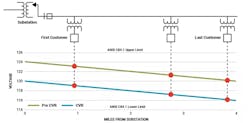Is Your Conservation Voltage Reduction Program Doing Enough to Beat the Heat?
Increasingly frequent and intense heatwaves are pushing utility power grids to their limits, and in many cases driving new energy usage records, as has recently been reported for the Texas power grid.
According to a report by NBC News, “The Electric Reliability Council of Texas, the agency that manages the power grid, said demand for electricity briefly topped 80,000 megawatts for the first time ever, exceeding even the worst-case scenario ERCOT envisioned in its most extreme forecasts prior to the start of the summer.”
That astoundingly high usage did not stay at 80,000 megawatts long enough to be considered an official record according to ERCOT. But it did exceed the combined peak energy demand for the same afternoon in California at 40,000 megawatts and New York at 30,000 megawatts.
The July 20th report went on to say, “ERCOT's seasonal forecast predicted the state would not top 77,000 megawatts this summer even in the most extreme weather -- so 80,000 megawatts is a number not expected by the experts. But this has been a summer of soaring heat and shattering power records. Wednesday was the 11th time this year that Texas set a new all-time record for consuming electricity.”
What are Utilities Doing to Shift Demand?
As demand approaches maximum grid capacity it’s more important than ever for utilities to reevaluate the effectiveness of their energy efficiency efforts and look for additional savings. Whether voluntary or driven by regulations, most utilities have energy savings and peak demand reduction goals and programs in place.
Demand response programs that incent customers to reduce or shift energy usage during peak periods have long been a widely used utility tool to impact energy efficiency. When there is sufficient customer participation, demand response programs produce positive results.
Conservation voltage reduction (CVR) is another energy reduction method that has been around for decades. It’s a cost-effective way to gain additional energy reduction beyond what demand response programs can provide. The idea behind CVR is to save energy by reducing voltage, but the challenge is to ensure that all customers still receive power at acceptable voltage levels.
Conservation Voltage Reduction
Utilities have successfully used CVR programs to reduce energy consumption without negative impact to customers. However, even more energy savings are possible for utilities that enhance their CVR programs.
Volt-VAR Optimization (VVO) is typically the primary operating strategy used for CVR. Loads that include motors such as large air conditioning systems, industrial machines and pumps are inductive and cause voltage to drop across the system. VVO programs address this problem by using reactive resources, like capacitors, to flatten and boost voltage profiles near inductive loads.
Until recently, most CVR technologies have been focused solely on the medium-voltage segments of the grid. These technologies are well-proven to reduce voltage, but broadening the scope of CVR/VVO to the low-voltage segments of the grid enables valuable additional savings.
More Energy Savings with Dynamic VAR Control
The idea of dynamic VAR controllers (DVCs) in the low-voltage segment of the grid is relatively new. Because traditional VVO equipment like load tap changers (LTCs), voltage regulators, and capacitor banks is at substations and along feeders operating at medium voltages, a low voltage energy saving approach may not be obvious. But identifying low voltage outliers that are below a utility’s lower limit (e.g. 114-118V) to maximize VVO energy savings can be very effective.
Sentient Energy’s dynamic VAR control system for the low voltage side of the grid does just that. The solution helps utilities identify the low-voltage outliers and uses smaller capacitors to bring up these low points and create more voltage margin. With more voltage margin, load tap changers (LTCs) and voltage regulators can be set to lower voltage levels to save energy while still meeting minimum voltage requirements in all locations.
Also, by addressing the voltage low points, upstream devices like LTCs won’t have to work as hard, extending their useful lives.
Sentient Energy’s Grid Edge Control enables utilities to take a more precise approach to CVR/VVO and find more energy savings. Installed exactly where it’s needed, low-voltage dynamic VAR control technology is an effective way to achieve more energy savings from VVO and your utility’s CVR program.
With well over 10,000 devices installed at leading electric utilities, dynamic VAR control in low voltage has been proven to deliver additional energy savings of 1%-3% beyond traditional CVR. And customers will experience similar benefits to those provided by a capacitor bank – increased voltage levels, improved power quality, less fluctuations and flicker.
Moreover, installing low-voltage dynamic VAR control solutions is not as disruptive and time consuming as installing solutions on medium voltage segments. Low-voltage DVCs can be installed on the low side of the distribution transformers without disturbing customers with an outage. This simplified deployment model accelerates the payback on investment.
Field Testing with ComEd
In a recent field trial ComEd augmented traditional VVO with Sentient Energy’s Grid Edge Control solution. The trial involved 52 low voltage DVCs on four feeders from three substations with combined Annual MWh of 99,130.
By adding 52 dynamic VAR controllers for low voltage, ComEd boosted VVO savings by 58% on these feeders, increasing energy savings from 2.11% to 3.34%.
Energy savings were derived from a standard Sentient Energy calculation method, different than Illinois TRM. The incremental savings results from dynamic VAR controllers are feeder dependent and may not be feasible on every feeder.
Reduced Impacts from PV Solar and EV
Low-voltage dynamic VAR control has other important benefits. Voltage fluctuation associated with intermittent power from rooftop solar generation can degrade power quality and increase wear and tear on equipment. This causes utilities to limit solar penetration on their distribution systems. Low-voltage dynamic VAR controllers help mitigate fluctuations and reliably host more rooftop solar generation on their distribution grid.
Additionally, low voltage dynamic VAR control improves the voltage profile at distribution transformers serving EV charging. This enhances power quality, reduces flicker during charging, and reduces strain on transformers extending their useful lives.
Improved Energy Savings and More
As intense heatwaves continue, the criticality of energy efficiency and peak demand reduction will only increase. Demand response and CVR programs are key strategies to improve energy efficiency and reduce peaks but more needs to be done for aging power grids to keep up with increasing demand and equipment stress.
More and more, utilities seeking to increase the energy savings they achieve with CVR programs are looking beyond VVO in the medium voltage side and into the low-voltage side. Low-voltage dynamic VAR control, like Sentient Energy’s Grid Edge Control solution, can deliver much-needed incremental energy savings of 1-3%, help utilities meet more stringent energy efficiency goals, improve power quality, increase solar hosting and help keep the power on during heatwaves.
About the Author
Steven Watt
Steven Watt is senior product manager for Sentient Energy.




